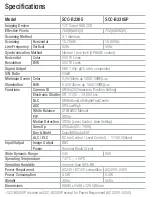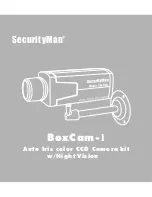
IQ-SA-360-FM 251012:IQ-SA-360-CS-W.qxd 10/26/12 5:40 PM Page 6
After choosing a suitable location (see previous section) install the unit as follows:
The unit is suitable for connection to a 230 V AC 50Hz electricity supply. An internal switch
should be installed to switch the power to the unit ON & OFF. This allows the sensor to be
easily switched off when not
required or for maintenance purposes and allows it to be
conveniently brought into manual
override.
Remove the wiring cover from the sensor by depressing the catch on the side and lifting it clear
of the twin locators opposite the catch (see diagram G)
Mark the position of the 75mm diameter locating hole centre, take care to avoid ceiling joists and
other obstructions within the 75mm diameter. Drill a pilot hole to take the centre shaft of a hole
cutter.
Use the hole cutter to cut the required hole.
CONNECTION
THERE ARE 2 POSSIBLE CONNECTION SCENARIOS
1. Standard connection. See Diagram E.
The factory fitted “bridge” wire must not be removed.
Connect the 3 or 4 core
mains supply cable
to the terminal block on the unit as follows:-
NEUTRAL (Blue)
N
EARTH (Green/Yellow)
LIVE (Brown)
L
Connect the fourth core ( lighting live ) of the four core cable ( if used ) to the L1 terminal block or
the second 3 core cable ( from the lighting ) to
L1
(brown),
N
(blue) and
E
(green / yellow).
SWITCHED LIVE
L1
2. Switching DC loads or loads which use a different phase or voltage supply from the AC
mains (see diagram F). Remove the factory fitted bridge wire.
Connect the 3 core
mains supply cable
to the terminal block on the unit as follows:-
NEUTRAL (Blue)
N
EARTH (Green/Yellow)
LIVE (Brown)
L
Connect the load in series with the load supply between L1 and L2 terminals.
Please note that the function of L1 L2 can viewed as a simple switch controlled by the PIR sensor
electronics.
*** IMPORTANT ***
Switch off the electricity at the fuse box by removing the relevant fuse or switching off
the circuit breaker before proceeding with the installation.
All fittings should be installed by a registered electrician.
SECTION THREE
INSTALLATION
IQ-SA-360-FM 251012:IQ-SA-360-CS-W.qxd 10/26/12 5:40 PM Page 7
When wiring is complete, set the two adjustment controls on the side of the unit (diagram D) to
the following position:
TIME - Fully anti-clockwise
DUSK - Fully clockwise
Push back the locating spring (diagram E) and feed the unit into the ceiling void via the 75mm
hole. The locating spring will now fold back and hold the unit in place.
WALK TESTING PROCEDURE
Set the two adjustment controls on the underside of the unit (diagram C) to the following
positions:
TIME - Fully anti-clockwise
DUSK - Fully clockwise
The unit will now operate during daytime as well as at night, illuminating the lamp for approx. 5
seconds each time. This allows testing to be carried out to establish whether the sensor is
covering the required area.
The lamp will immediately illuminate as the unit goes through its "warm-up" period. After
approximately 1 - 2 minutes the lamp will extinguish. Try to remain outside the detection area
during the warm-up period.
Walk around the sensor to establish the detection area. The sensor will detect within an
approximately six metres diameter circle from the centre of the sensor location with 2.5m ceiling
height.
As you cross a detection "zone" the lamp will illuminate. Now, stand still until the lamp
extinguishes (this should take approx. 5 seconds).
Start moving again. As you cross each "zone" the lamp will illuminate.
Repeat the above, walking at various distances and angles to the unit. This will help you to
establish the detection pattern.
MASKING THE SENSOR LENS
To reduce the sensor coverage, preventing detection in unwanted areas, mask the sensor lens
using the lens mask sticker supplied (see diagram C). For your information, the centre section of
the lens covers short range detection, and the outer edge of the lens covers long range. Mask
the sensor to suit your installation.
SECTION FOUR
OPERATION AND TESTING
Mark the position of the 75mm diameter locating hole centre, take care to avoid ceiling joists
and other obstructions within the 75mm diameter. Drill a pilot hole to take the centre shaft of
a hole cutter.
Use the hole cutter to cut the required hole.




























